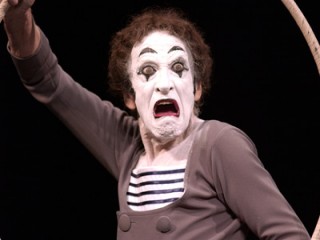
Marcel Marceau biography
Date of birth : 1923-03-22
Date of death : 2007-09-22
Birthplace : Strasbourg, France
Nationality : French
Category : Famous Figures
Last modified : 2011-11-05
Credited as : actor and mime, Bip the Clown, National Order of Merit
Marcel Marceau has been acknowledged as the world's greatest practitioner of pantomime. He revived this ancient form of acting and created a new school to train young people who aspired to follow his style.
Marcel Marceau was born in Strasbourg, France. His father, Charles, was a butcher and his mother, Ann, nee Werzberg, was a native Alsatian. Later the family moved to Lille where his father also raised pigeons on the roof. Marcel remembered in his mature years that he was raised hearing the sound of wing beats. The sound enchanted him; so did silent films. Borrowing his father's pants and using ink to paint on a moustache, he tried to imitate the famous comedian of the silent screen. Soon he began imitating birds, plants, trees, and eventually people. Encouraged by his parents, he turned to a career in the theater. Much later—in 1967—he met Chaplin for the first time, only briefly between planes at Paris' Orly Airport, where they expressed their mutual admiration. He was deeply touched. When parting he brought the old man's hands to his lips and kissed them.
Marceau returned to Alsace, where he entered the Lycee Fustel de Coulanges. But he was unable to complete his training. In 1940, just ahead of the German invaders, he sought refuge in Limoges. There he studied ceramics, and at the age of 17 he won the Masson prize for his enamel work. He also studied oratory with Dorsanne. The war, however, brought personal tragedy. His father was seized by the Germans and died in Auschwitz. Marcel joined his brother in the resistance movement; his activities consisted of making fake ration cards and smuggling children into Switzerland.
When the police began to close in, Marceau fled to Paris where a cousin saved him by placing him in the Maison d'Enfants de Sèvres, an orphanage. There Marceau taught dramatics. In his spare time he also began studying with Charles Dullin in the Sarah Bernhardt Theatre. He also came under the tutelage of the master of mime, Etienne Decroux, of whom he said, "He was a kind of Christ…. In his class we dedicated our bodies to the discipline of silence." The art of pantomime did not attract many students, and even fewer spectators; in fact, the children of the Maison de Sèvres were his first audience. Small wonder that he came to believe that chiefly the young understood his art. Decroux was his most critical admirer and told him, "Marceau, you are a born mime." He interrupted his studies in December, 1944, to join the French army. In Germany he played in a military theater before troops until he was demobilized in 1946. Immediately he returned to playing minor roles at the Sarah Bernhardt Theater. As a member of the Decroux Company he put on his first mimodrama, "Praxitele and the Golden Fish," which won enough praise to launch his career.
In 1947 Marceau set up his own company at the Theatre de Poche (Pocket Theatre), a tiny hall with only 80 seats. Here he created his own whitefaced clown, Bip, a name he derived from the youngster Pip in Charles Dickens' novel Great Expectations. Bip's costume consisted of a broken top hat with a red flower and striped pull-over middy to symbolize the gaiety of Paris streets and white pants. Bip first appeared on Marceau's 24th birthday in "Bip and the Street Girl." Pantomime did not attract large audiences at first, and he had to perform in cabarets to earn enough to live on until he won success in 1952 with "Pierrot of Montmartre" in the 1,200 seat Sarah Bernhardt Theatre. By this time Marceau had attained fame beyond the confines of Paris and France. In 1949 his company toured Israel and Holland, in 1951 it played in Berlin, in 1955 the United States and Canada. Beginning in New York, the tour—originally scheduled for two weeks—lasted three months. This enabled him to become famous not just in Europe, but throughout the world. "When I went back to Paris after being a hit on Broadway in 1955, everything changed for me. It was a new, almost frightening experience," he recalled in the New York Times.
Marceau also found himself involved in other media. Television offered him vast audiences; he even won two Emmy Awards from the Academy of Television Arts and Sciences, and showed himself to be articulate when he was interviewed. Through his work, Marceau obtained a knighthood in the French Legion of Honor, an officer's rank in the National Order of Merit, and a comedy rank in the National Order of Arts and Letters of France. He appeared in six feature films, among them Barbarella (1968), Shanks (1974), in which he played the leading role, and Silent Movie. He also wrote a novel, Pimparello.
Marceau truly became a worldwide figure, eventually giving 18,000 performances in over a hundred countries. Marceau's original mime company disbanded in 1964, but in the 1980s a subsidy from the French government enabled him to form a new company, with graduates from his Paris mime school. The latter was founded in 1978, and instructed students in the art of mime. Among the often-sophisticated plots Marceau used in his performances were adaptations of Gogol's The Overcoat and Kafka's The Trial. He acknowledged owing a great deal to the silent comics, including Chaplin, Buster Keaton, and Harold Lloyd. Marceau summed up his career in the New York Times by commenting, "The art of mime is an art of metamorphosis…. [Y]ou cannot say in mime what you can say better in words. You have to make a choice. It is the art of the essential. And you cannot lie. You have to show the truth."





















